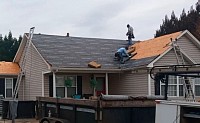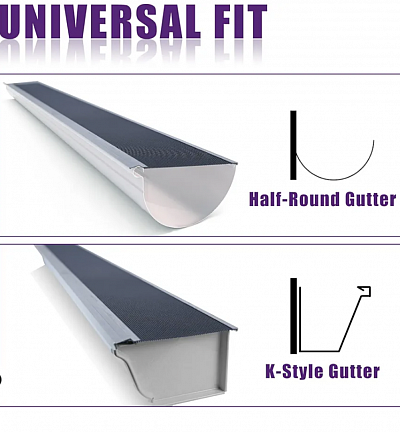Seamless Gutter Types & Gutter Guards
Types of Seamless Gutters
Types of Seamless Gutters
Vinyl: Vinyl gutters are the cheapest gutters. Seamless vinyl gutters’ costs range from $2 to $6 per foot. Vinyl is lightweight, so it takes little time to install. These gutters are not suitable for extreme weather. Due to their plastic nature, they expand and contract, causing cracks in the gutters.
Aluminum: Seamless aluminum gutters come in brown, dark blue, red, gray, and green colors. Aluminum gutters hold up well against harsh weather. Even when the paint wears off, seamless aluminum gutters will not rust.
Galvalume: These are steel gutters with a coating of aluminum and zinc. Combining the three materials gives a strong and non-corrosive gutter system.
Gutter Helmets & Types
Not all gutter guards are created equal, but it’s more complicated than simply choosing the best one. Some designs are more effective for certain debris or different climates, while others may not mesh with the aesthetics of your home.
Below are the types of gutter guards you should be familiar with when assessing your options.
Screen Gutter Guards
Screen gutter guards are perforated metal or plastic sheets that lay on top of the gutter. The material’s holes block medium to large debris while still letting water flow through. Because the holes are fairly large, screen gutter guards are inefficient at blocking tiny debris like pine needles, pollen, and shingle grit. Their light construction also makes them inadvisable in windy areas, where they can blow off the gutter.
Overall, screen gutter guards are good for DIY installation and affordable compared to more durable options, but their life span is short and they don’t reduce the required frequency of cleaning as much as some options.
Mesh Gutter Guards
Mesh gutter guards often perform better than screen guards and strike a balance between filtration and water flow. They consist of a flat perforated barrier, like screen guards, but the holes are smaller. This allows them to block a larger variety of pests and debris.
You can choose between metal and plastic options and multiple installation styles. Hiring professional contractors for installation is recommended if you’re not particularly handy. It’s also best to avoid products that slide under your shingles, which can jeopardize your roof warranty, and flimsier options, which might blow away in the wind.
Micro-Mesh Gutter Guards
Micro-mesh gutter guards have finely woven mesh screens that keep even the smallest debris at bay. They’re great for areas where pollen, pine needles, and dirt are common, and experts generally agree they are the most effective design on the market today. However, their superior filtration comes at the cost of flow rate; it’s important to be careful when installing them in high-flow areas, such as roof valleys.
These gutter guards are designed for professional installation and often include additional services, such as gutter cleaning and sealing. Though some DIY options are available, these gutter guards are designed for professional installation. Some providers will also clean and seal your gutters and point out potential problems that could lead to damage in the future.
Reverse-Curve Gutter Guards
Reverse-curve gutter guards, also called surface-tension guards, are an old but effective design for blocking debris from entering your gutters. They feature a plastic or aluminum hood with a curved edge that leaves a slot between the guard and the gutter lip. Water flows down the hood, around the curve, and back into the gutter while debris slides off to the ground below.
While this is one of the most effective designs available, it’s not perfect. Surface tension diminishes when water gains too much momentum, making it possible for water to shoot over the edge of your gutter during heavy rain. It also inserts under your shingles to match your roof’s pitch, which may conflict with your roof warranty.
Surface-tension gutter guards are visible from the street, which could clash with your home’s aesthetics, as well. Most companies offer multiple colors to help them blend in with your existing roof and gutters.
Brush Gutter Guards
Brush gutter guards resemble large pipe cleaners in the gutter’s trough. Conceptually, water flows through the bristles while debris gets caught. Because gutter brushes trap debris instead of shedding it, they have to be removed for cleaning more frequently than other designs. They’re also not durable under harsh sunlight, meaning you may have to replace them every few years.
The advantages of gutter brushes include unmatched affordability and ease of installation. If you’re looking for a durable and effective gutter guard that will last the life of your home, though, gutter brushes are not worth considering.
Foam Gutter Guards
Foam gutter guards are affordable and easy to install but should be a temporary solution if used at all. Triangular foam pieces sit inside the gutter, allowing water to flow through the porous material while debris stays on top.
When the foam is wet, it presents favorable conditions for seedlings and trees to grow inside the guard, damaging your gutters or possibly catching fire. Additionally, many customers have reported that the foam deteriorates quickly due to sun and other weather conditions and requires frequent cleaning.



